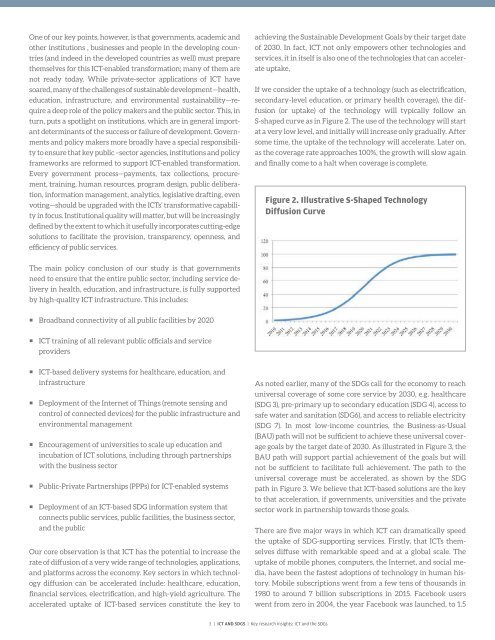& SDGs
3yewwB
3yewwB
You also want an ePaper? Increase the reach of your titles
YUMPU automatically turns print PDFs into web optimized ePapers that Google loves.
One of our key points, however, is that governments, academic and<br />
other institutions , businesses and people in the developing countries<br />
(and indeed in the developed countries as well) must prepare<br />
themselves for this ICT-enabled transformation; many of them are<br />
not ready today. While private-sector applications of ICT have<br />
soared, many of the challenges of sustainable development—health,<br />
education, infrastructure, and environmental sustainability—require<br />
a deep role of the policy makers and the public sector. This, in<br />
turn, puts a spotlight on institutions, which are in general important<br />
determinants of the success or failure of development. Governments<br />
and policy makers more broadly have a special responsibility<br />
to ensure that key public –sector agencies, institutions and policy<br />
frameworks are reformed to support ICT-enabled transformation.<br />
Every government process—payments, tax collections, procurement,<br />
training, human resources, program design, public deliberation,<br />
information management, analytics, legislative drafting, even<br />
voting—should be upgraded with the ICTs’ transformative capability<br />
in focus. Institutional quality will matter, but will be increasingly<br />
defined by the extent to which it usefully incorporates cutting-edge<br />
solutions to facilitate the provision, transparency, openness, and<br />
efficiency of public services.<br />
achieving the Sustainable Development Goals by their target date<br />
of 2030. In fact, ICT not only empowers other technologies and<br />
services, it in itself is also one of the technologies that can accelerate<br />
uptake,<br />
If we consider the uptake of a technology (such as electrification,<br />
secondary-level education, or primary health coverage), the diffusion<br />
(or uptake) of the technology will typically follow an<br />
S-shaped curve as in Figure 2. The use of the technology will start<br />
at a very low level, and initially will increase only gradually. After<br />
some time, the uptake of the technology will accelerate. Later on,<br />
as the coverage rate approaches 100%, the growth will slow again<br />
and finally come to a halt when coverage is complete.<br />
Figure 2. Illustrative S-Shaped Technology<br />
Diffusion Curve<br />
The main policy conclusion of our study is that governments<br />
need to ensure that the entire public sector, including service delivery<br />
in health, education, and infrastructure, is fully supported<br />
by high-quality ICT infrastructure. This includes:<br />
• Broadband connectivity of all public facilities by 2020<br />
• ICT training of all relevant public officials and service<br />
providers<br />
• ICT-based delivery systems for healthcare, education, and<br />
infrastructure<br />
• Deployment of the Internet of Things (remote sensing and<br />
control of connected devices) for the public infrastructure and<br />
environmental management<br />
• Encouragement of universities to scale up education and<br />
incubation of ICT solutions, including through partnerships<br />
with the business sector<br />
• Public-Private Partnerships (PPPs) for ICT-enabled systems<br />
• Deployment of an ICT-based SDG information system that<br />
connects public services, public facilities, the business sector,<br />
and the public<br />
Our core observation is that ICT has the potential to increase the<br />
rate of diffusion of a very wide range of technologies, applications,<br />
and platforms across the economy. Key sectors in which technology<br />
diffusion can be accelerated include: healthcare, education,<br />
financial services, electrification, and high-yield agriculture. The<br />
accelerated uptake of ICT-based services constitute the key to<br />
As noted earlier, many of the <strong>SDGs</strong> call for the economy to reach<br />
universal coverage of some core service by 2030, e.g. healthcare<br />
(SDG 3), pre-primary up to secondary education (SDG 4), access to<br />
safe water and sanitation (SDG6), and access to reliable electricity<br />
(SDG 7). In most low-income countries, the Business-as-Usual<br />
(BAU) path will not be sufficient to achieve these universal coverage<br />
goals by the target date of 2030. As illustrated in Figure 3, the<br />
BAU path will support partial achievement of the goals but will<br />
not be sufficient to facilitate full achievement. The path to the<br />
universal coverage must be accelerated, as shown by the SDG<br />
path in Figure 3. We believe that ICT-based solutions are the key<br />
to that acceleration, if governments, universities and the private<br />
sector work in partnership towards those goals.<br />
There are five major ways in which ICT can dramatically speed<br />
the uptake of SDG-supporting services. Firstly, that ICTs themselves<br />
diffuse with remarkable speed and at a global scale. The<br />
uptake of mobile phones, computers, the Internet, and social media,<br />
have been the fastest adoptions of technology in human history.<br />
Mobile subscriptions went from a few tens of thousands in<br />
1980 to around 7 billion subscriptions in 2015. Facebook users<br />
went from zero in 2004, the year Facebook was launched, to 1.5<br />
3 | ICT AND SDGS | Key research insights: ICT and the <strong>SDGs</strong>







